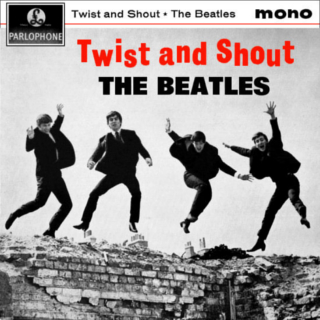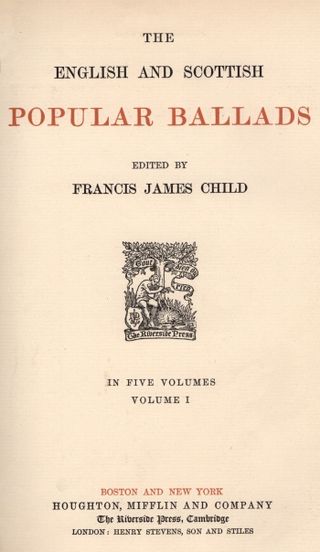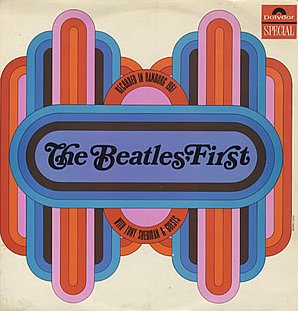
Bert Kaempfert was a German orchestra leader, multi-instrumentalist, music producer, arranger, and composer. He made easy listening and jazz-oriented records and wrote the music for a number of well-known songs, including "Strangers in the Night", “Danke Schoen” and "Moon Over Naples".

Anthology 1 is a compilation album by the Beatles, released on 20 November 1995 by Apple Records as part of The Beatles Anthology series. It features rarities, outtakes and live performances from the period 1958–64, including songs with original bass player Stuart Sutcliffe and drummer Pete Best. It is the first in a trilogy of albums with Anthology 2 and Anthology 3, all of which tie in with the televised special The Beatles Anthology. It contains "Free as a Bird", the first new Beatles song in 25 years, which was released as a single two weeks after Anthology 1.

Anthony Esmond Sheridan McGinnity, known professionally as Tony Sheridan, was an English rock and roll guitarist who spent much of his adult life in Germany. He was best known as an early collaborator of the Beatles, one of two non-Beatles to receive label performance credit on a record with the group, and the only non-Beatle to appear as lead singer on a Beatles recording which charted as a single.

My Bonnie is a 1962 album by English rock and roll singer-songwriter and musician Tony Sheridan. Sheridan, then playing in clubs in Hamburg with the Beatles, was discovered by producer Bert Kaempfert and subsequently signed with him to record for Polydor. Sheridan recorded several songs with the Beatles, of which only a single was released in 1961, the titular "My Bonnie" and B-side "The Saints", credited to Tony Sheridan and the Beat Brothers. While both songs are included here, the remaining tracks on this album were credited again to the Beat Brothers but recorded without the Beatles.

"Sweet Georgia Brown" is a jazz standard composed in 1925 by Ben Bernie and Maceo Pinkard, with lyrics by Kenneth Casey.

"Silver Dagger", with variants such as "Katy Dear", "Molly Dear", "The Green Fields and Meadows", "Awake, Awake, Ye Drowsy Sleepers" and others, is an American folk ballad, whose origins lie possibly in Britain. These songs of different titles are closely related, and two strands in particular became popular in commercial Country music and Folk music recordings of the twentieth century: the "Silver Dagger" version popularised by Joan Baez, and the "Katy Dear" versions popularised by close harmony brother duets such as The Callahan Brothers, The Blue Sky Boys and The Louvin Brothers.

Twist and Shout is the first UK extended play by the English rock band the Beatles, released in the UK on EMI's Parlophone label on 12 July 1963. It contains four tracks produced by George Martin that were previously released on the band's debut album Please Please Me. Rush-released to meet public appetite, the record topped the UK EP chart for twenty-one weeks, the biggest-selling EP of all time in the UK to that point, and became so successful that it registered on the NME Singles Chart, peaking at number four. The EP's cover photograph, featuring the Beatles jumping in a London bombsite, has been described by The Telegraph as "one of the key images of the 1960s".

"The Raggle Taggle Gypsy" (Roud 1, Child 200), is a traditional folk song that originated as a Scottish border ballad, and has been popular throughout Britain, Ireland and North America. It concerns a rich lady who runs off to join the gypsies (or one gypsy). Common alternative names are "Gypsy Davy", "The Raggle Taggle Gypsies O", "The Gypsy Laddie(s)", "Black Jack David" (or "Davy") and "Seven Yellow Gypsies".

"Cry for a Shadow" is an instrumental rock piece recorded by the Beatles on 22 June 1961. They recorded the song at Friedrich-Ebert-Halle within the gymnasium, Hamburg, West Germany while they were performing as Tony Sheridan's backing band for a few tracks, under the moniker the Beat Brothers. It was written by George Harrison with John Lennon, as a pastiche of the Shadows' style. It is the only Beatles track to be credited to Lennon and Harrison alone.
The Bonnie Lass o' Fyvie is a Scottish folk song about a thwarted romance between a soldier and a girl. Like many folk songs, the authorship is unattributed, there is no strict version of the lyrics, and it is often referred to by its opening line "There once was a troop o' Irish dragoons". The song is also known by a variety of other names, the most common of them being "Peggy-O", "Fennario", and "The Maid of Fife".

The Beatles with Tony Sheridan and Their Guests was an American compilation album that included "Cry for a Shadow", an instrumental written and recorded by The Beatles, plus three other recordings with the fledgling group backing fellow British guitarist and vocalist Tony Sheridan.

The Beatles' First! is a German compilation album of songs recorded in Hamburg in 1961 and 1962 by Tony Sheridan with the Beatles as his backing group. It was originally released in 1964 in Germany, then issued in 1967 in England, 1969 in Canada and finally in the United States in 1970.
"Bonnie Annie" is a folk ballad recorded from the Scottish and English traditions. Scottish texts are often called Bonnie Annie or The Green Banks of Yarrow, English texts are most often called The Banks of Green Willow. Other titles include The Undutiful Daughter, The High Banks O Yarrow, The Watery Grave, Green Willow, There Was a Rich Merchant that Lived in Strathdinah and The Merchant's Daughter.
"The Trees They Grow So High" is a Scottish folk song. The song is known by many titles, including "The Trees They Do Grow High", "Daily Growing", "Long A-Growing" and "Lady Mary Ann".
"Mary Don't You Weep" is a Spiritual that originates from before the American Civil War – thus it is what scholars call a "slave song", "a label that describes their origins among the enslaved", and it contains "coded messages of hope and resistance". It is one of the most important of Negro spirituals. It is listed as number 11823 in the Roud Folk Song Index.
"Hallelujah I Love Her So" is a single by American musician Ray Charles. The rhythm and blues song was written and released by Charles in 1956 on the Atlantic label, and in 1957 it was included on his self-titled debut LP, also released on Atlantic. The song peaked at number five on the Billboard R&B chart. It is loosely based on 'Get It Over Baby' by Ike Turner (1953).
"Katie Cruel" is a traditional American folksong, likely of Scottish origin. As a traditional song, it has been recorded by many performers, but the best known recording of the song is by Karen Dalton on the album In My Own Time. The American version of the song is said to date to the Revolutionary War period. The song is Roud no. 1645.

"Take Out Some Insurance" is a blues song released in 1959 by Jimmy Reed written by Charles Singleton and Waldenese Hall but originally credited to Jesse Stone. The copyright registration for the song lists its title as "Take Out Some Insurance on Me, Baby".. Tony Sheridan recorded it with different lyrics in 1961 with The Beatles as his backing band. Misidentified, it was released in Germany in 1964 as "If You Love Me, Baby " but subsequently as "Take Out Some Insurance on Me, Baby ", "Take Out Some Insurance on Me, Baby" or erroneously as "If You Love Me, Baby".
"Blow the Wind Southerly" is a traditional English folk song from Northumbria. It tells of a woman desperately hoping for a southerly wind to blow her lover back home over the sea to her. It is Roud number 2619.
Roy Frederick Young was a British rock and roll singer, pianist and keyboard player. He first recorded in the late 1950s before performing in Hamburg with the Beatles. After a stint with Cliff Bennett and the Rebel Rousers, he released several albums with his own band as well as recording with Chuck Berry and David Bowie, among others.













